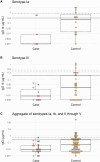Epidemiology of Group B Streptococcus: Maternal Colonization and Infant Disease in Kampala, Uganda
- PMID: 40201722
- PMCID: PMC11977330
- DOI: 10.1093/ofid/ofaf167
Epidemiology of Group B Streptococcus: Maternal Colonization and Infant Disease in Kampala, Uganda
Abstract
Background: Child survival rates have improved globally, but neonatal mortality due to infections, such as group B Streptococcus (GBS), remains a significant concern. The global burden of GBS-related morbidity and mortality is substantial. However, data from low and middle-income countries are lacking. Vaccination during pregnancy could be a feasible strategy to address GBS-related disease burden.
Methods: We assessed maternal rectovaginal GBS colonization and neonatal disease rates in a prospective cohort of 6062 women-infant pairs. Surveillance for invasive infant disease occurred in parallel at 2 Kampala hospital sites. In a nested case-control study, we identified infants <90 days of age with invasive GBS disease (iGBS) (n = 24) and healthy infants born to mothers colonized with GBS (n = 72). We measured serotype-specific anticapsular immunoglobulin G (IgG) in cord blood/infant sera using a validated multiplex Luminex assay.
Results: We found a high incidence of iGBS (1.0 per 1000 live births) within the first 90 days of life across the surveillance sites, associated with a high case fatality rate (18.2%). Maternal GBS colonization prevalence was consistent with other studies in the region (14.7% [95% confidence interval, 13.7%-15.6%]). IgG geometric mean concentrations were lower in cases than controls for serotypes Ia (0.005 vs 0.12 µg/mL; P = .05) and III (0.011 vs 0.036 µg/mL; P = .07) and in an aggregate analysis of all serotypes (0.014 vs 0.05 µg/mL; P = .02).
Conclusions: We found that GBS is an important cause of neonatal and young infant disease in Uganda and confirmed that maternally derived antibodies were lower in early-onset GBS cases than in healthy exposed controls.
Keywords: anticapsular antibody; correlate of protection; group B Streptococcus; invasive disease; risk reduction.
© The Author(s) 2025. Published by Oxford University Press on behalf of Infectious Diseases Society of America.
Conflict of interest statement
Potential conflicts of interest. All authors: No potential conflicts of interest.
Figures



References
Grants and funding
LinkOut - more resources
Full Text Sources

